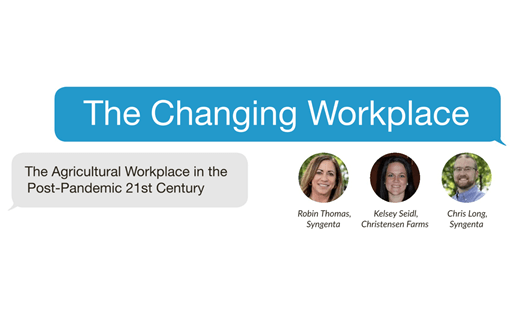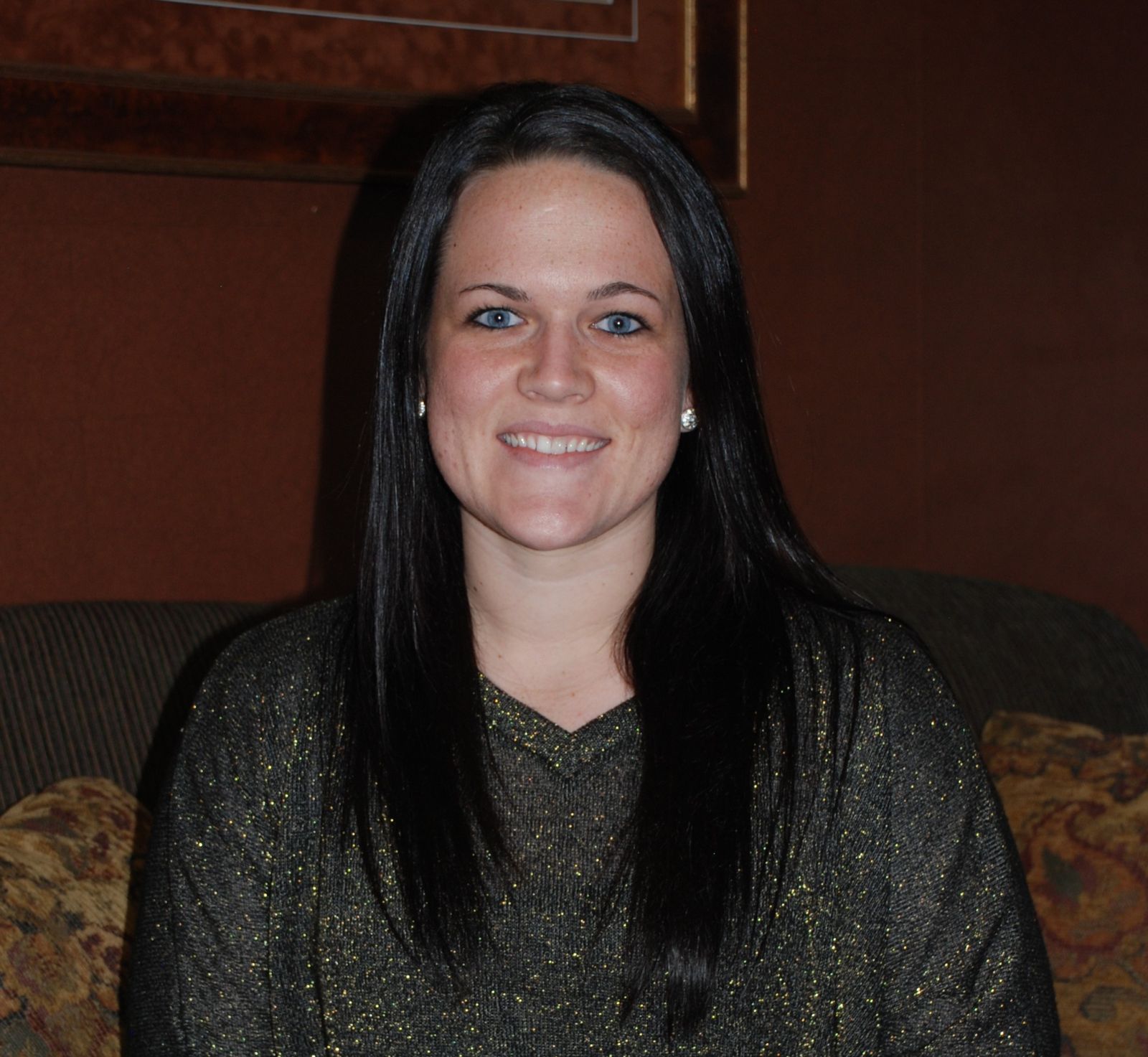- Candidates
- Login
- Setup Account
- Search Tools
- Resources
- Employers
- Employers
- Setup Account
- Login
- Products
- Resources

The Changing Workplace
GIFs. Working from home. Working in gym shorts. The agricultural workplace is looking different in many ways. And it was even before the onset of the COVID-19 global pandemic, which will almost certainly leave a permanent mark on the workplace as we know it. Students being taught to expect one thing may face a workplace a bit different from what they originally pictured.
To give a better understanding of what the American agricultural workplace might look like for young people entering the working world, we consulted with human resources and hiring professionals about what long-held expectations are no longer always correct or applicable as well as what changes they expect in the workplace because of the COVID-19 pandemic.
 |
 |
 |
| Robin Thomas, Syngenta | Kelsey Seidl, Christensen Farms | Chris Long, Syngenta |
Communication Practices
A noticeable change in the American agricultural workplace is traditional communication practices. Younger generations (late Millennials and Generation Z’ers) communicate more visually in pictures and images such as GIFs, memes, emojis, and even TikTok videos. Although long considered inappropriate in the workplace, these informal and often humorous methods of communication have worked their way internally at many companies in email and instant messaging.
“It is always important to communicate clearly and effectively, but the manner in which it is done has evolved over time,” said Robin Thomas, Early Talent Acquisition Lead with Syngenta US, who shared that this form of communication is now used in some of their internal messages. “Some of us are more comfortable using emojis, GIFs, and informal language at work, but it is important to use it only when appropriate.”
Kelsey Seidl, Talent Acquisition Recruiter with Christensen Farms, noted that there are pros and cons to this shift. “The pros being it has allowed for more open dialogue and connection within the workplace simply due to a much more relaxed setting with peers, managers and executives,” Seidl said. “On the flip side, this shift does come with its challenges. I think with the acceptance of less formality in communication in the workplace, comes a lag in some important, more formal skills required, such as writing, presenting, direct conversation, etcetera.”
The underlying message here is that you should still refrain from sending GIFs and emojis to hiring managers, clients, business partners, your company leadership, and other crucial contacts, but when conversing with internal colleagues, this informal, laid back communication may be permissible, depending on your workplace culture. No matter how you communicate, be sure that your written and spoken communication skills do not suffer because of more informal day-to-day practices.
Where and How We Work & What We Wear
Changes to traditional workplace flexibility and the ability to work remotely had changed even prior to the pandemic, but it is something agricultural professionals see being impacted even more due to COVID-19. Flexibility has long been a sought-after if unwritten benefit in many workplaces, as several roles come with the capability to work in a remote setting. This element is also attractive to employees with young children as it allows them to work around kids home sick or their children’s activities.
“Many employers have gone away from the coined 8-5 job and transitioned to a schedule with greater flexibility to allow for individualized needs and a greater work-life balance,” Seidl said. However, there will always be career paths and industries within agriculture that will require employees at work or on-call at all times. “Pigs must be cared for each and every day – something that simply can’t be accomplished from home or in a remote setting,” Seidl noted.
With shifts in workplace location and scheduling, there has also been a shift in workplace attire for some businesses. “We want to set a professional image by being dressed neatly and appropriate for our work during business hours and whenever we are representing the company,” Thomas shared regarding Syngenta’s dress code. “At the same time, we have recognized the opportunity to allow employees to dress as they would during their off-hours, include wearing jeans, when not interfacing with clients.”
Seidl, however, shared that Christensen Farms still expects their employees to “dress to instill confidence in those you are working with.” “Pending your role, your audience and the end goal, this can range from business casual to business professional dress,” Seidl said. For roles not normally facing the public or clientele, such as animal caretakers with Christensen Farms or scientists at Syngenta, these policies are laxer. “If you are working on the farm, it’s important that those individuals can dress for comfort, safety, and efficiency being a highly labor-intensive role within our company,” Seidl shared.
A Focus on Diversity and Inclusion
You may have heard your career services representative, or your professor advise you to avoid topics around religion and politics in the workplace. While this may be applicable advice during the hiring and interview process, many agricultural workplaces welcome and embrace diversity of thought just as they have diversity of their workforce itself.
“We have a strong commitment to diversity, inclusion, and belonging that pre-dates recent events,” Thomas stated. “Some of the resources we have include dedicated internal web pages, employee training, and multiple Employee Resource Groups (ERG) that are employee-led groups formed around common interests, issues, and/or backgrounds.”
Christensen Farms has also developed ERG’s into their organization within the last two years open to all employees and not exclusive to the named group. “Our first ERG group formed back in 2018 and has served as an avenue to give employees a sense of belonging, while building on a culture of inclusion across the broader organization,” Seidl shared. “Regardless of what a person’s belief system may be, we focus on respecting one another, fostering inclusion and doing what needs to be done to achieve our work and ultimately our mission.”
The Lasting Effects of COVID-19
Besides the many changes the agricultural workplace has experienced in the last five years, it is rapidly having to shift due to the onset of the global COVID-19 pandemic. Most workplaces implemented safety procedures that have made the employee experience significantly different.
Chris Long, North American HR Generalist for Syngenta, shared that it’s uncertain whether disease preventative practices like encouraging the usage of face masks and social distancing will forever remain the norm, but “it’s definitely long term at this point.” “We are constantly reevaluating what jobs can allow for greater flexibility to work from home when and where it makes sense,” Long added. “We have scaled up our VPN network in order to better support our workforce as we move toward more and more virtual engagement.”
Seidl shared that Christensen Farms has implemented “mitigation efforts such as temperature-taking and pre-screening questions” before employees enter their work locations and “mass distribution of necessary PPE such as masks” and sanitizers. “It is unknown what will remain permanent in the changes we have made and what potentially goes away,” Seidl said. “What it has taught us is to be more agile in our work and creative in how we are able to get the work done.”
As the pandemic has created challenges regarding employee wellness and adjustment, Syngenta has also created an online portal to provide resources and interaction for their employees. “Ergonomics are more important than ever as employees learn to work from anywhere that’s not their typical office setup, so we provide informational resources to educate our employees on how best to work from home,” Long shared.
Still, take seriously what you’ve been told about the agricultural workplace, as professionalism is vital during the hiring process. But that doesn’t mean it’s stuffy and uncooperative. Agricultural employers are eager to make their employees feel comfortable, welcome, and empowered to succeed in their roles.